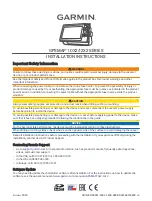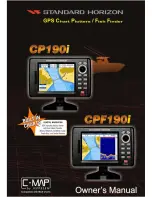
43
sonar signal cone, the image appears on the screen as a long line in-
stead of a fish arch. Reducing the chart speed may result in a shorter
line that more closely resembles a regular fish return.
To adjust Chart Speed, repeatedly press
MENU
until the
C
HART
S
PEED
scroll bar appears. Press
↑
to increase the speed of the chart. Press
↓
to
decrease it. Press
PWR
to clear the menu.
To return to the original setting, repeat the steps above, but use
↑
to
set the speed to
100%
before clearing the menu.
Frequency
The FishEasy 250 DS has a Dual Search transducer that can transmit
signals at 83 kHz and 200 kHz. The SeaFinder 250 DF is packed with a
Dual Frequency transducer that transmits at 50 kHz and 200 kHz.
The 200 kHz signal is best used in shallow water (about 300 feet or
less). This frequency is the best choice for about 80 percent of the fresh
and salt water sport fishing applications. When you get into very deep
salt water, up to 1,000 feet, the 83 kHz or 50kHz frequencies will work
best.
The 200 kHz transducer offers better detail and definition, but less depth
penetration. With the 83 kHz or 50 kHz frequencies, you will not get as
much detail or definition, but will benefit from greater depth penetration.
The 83 kHz also has up to 120
°
of wide fish-finding coverage. Remember,
all sonar units typically read deeper in fresh water than in salt water.
Содержание FishEasy 250 DS
Страница 10: ...6 Notes ...
Страница 62: ...58 Notes ...
Страница 67: ...63 Notes ...
Страница 68: ...64 Notes ...
































